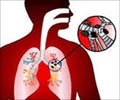Passive Smoking
A non-smoker who breathes other people's smoke is called passive smoking. It is also called as involuntary or secondhand smoking. Passive smoking is particularly dangerous as the passive smoker inhales - The smoke from the burning tip of the cigarette (side stream smoke) The smoke that has been exhaled by the smoker (mainstream smoke) Passive smoking consists mainly of side stream smoke. Side stream smoke contains much higher levels of many of the poisons and cancer-causing chemicals in cigarettes and is about four times more toxic than mainstream smoke. Second hand smoke comprises of up to three times more carbon monoxide, five times more cadmium and about 15 times more benzene.
The various chemicals and carcinogens in the cigarette smoke can cause smoking related diseases similar to ones acquired by actual smoking. Effects of passive smoking - Effects of passive smoking depend on the exposure levels and duration of exposures. It can be immediate or late effects. The chemicals in the cigarette smoke can cause irritation of the eyes, headache, cough, sore throat, and nausea. Studies have shown that in patients with asthma, exposure to smoke can reduce the lung function significantly and new cases of asthma can be induced in children who are exposed to cigarette smoke. A major review by the Government-appointed Scientific Committee on Tobacco and Health (SCOTH) stated that passive smoking is the cause of lung cancer and ischemic heart disease in adult non-smokers, and the cause of respiratory disease, cot death, middle ear disease and asthmatic attacks in children. Passive smoking increases the risk of getting frequent lower respiratory tract infections in children. Passive smoking during childhood predisposes children to develop cancer as adults. Exposure to passive smoking during pregnancy can lead to the birth of low birth weight babies.












